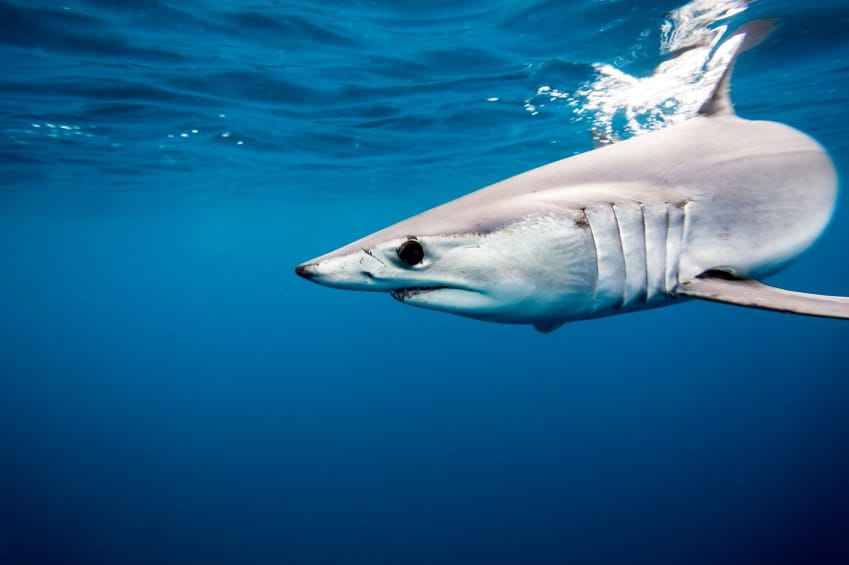Hey there, ocean enthusiasts! Are you ready to dive into the captivating world of mako sharks? Buckle up as we uncover the thrilling facts that make these speed demons of the deep one of the most fascinating creatures to swim the oceans. From their lightning speed and exceptional senses to their mysterious behaviors, get ready to be mesmerized!
Interesting Facts About Mako Sharks
Mako sharks are like the cheetahs of the ocean – incredibly fast and agile! But their speed is just the tip of the iceberg when it comes to these incredible creatures.
Brainy Beauties:
Forget the myth of sharks being mindless eating machines – makos are surprisingly intelligent creatures. They have the largest brain-to-body ratio of any shark species, suggesting a capacity for complex hunting strategies and problem-solving. Some experts believe this intelligence allows them to learn from past hunting experiences and adapt their strategies.
Warm-Blooded Wonders:
While most fish are cold-blooded, makos are partially warm-blooded, meaning they can regulate their own body temperature. This ability, called endothermy, allows them to maintain a higher body temperature than the surrounding water – a crucial advantage for hunting in colder waters and migrating across vast distances. Researchers are still studying the full extent of their thermoregulation and its impact on their lifestyle.
Guardians of the Deep:
As apex predators, mako sharks sit at the top of the food chain. Their presence helps regulate prey populations and ensures a balanced ocean ecosystem. Imagine a world without makos – their absence could lead to an overabundance of certain species and disrupt the delicate balance of the marine environment.
Unveiling the Unknown:
Despite their impressive abilities, mysteries still surround mako sharks. For instance, scientists are working to fully understand their migratory patterns. Tracking these movements is crucial for developing effective conservation strategies.
Mako sharks also possess unique physiological adaptations that have piqued the interest of the biotechnology field. Their blood, for example, contains a special type of antibody that could hold clues for developing new medicines and treatments for human diseases. Could these sharks hold the key to unlocking groundbreaking medical advancements?
Here’s a quick look at some of those amazing mako traits:
| Trait | Description |
|---|---|
| Speed | Average 31 mph, with bursts up to 60 mph, even reaching 90 mph in short sprints |
| Intelligence | Largest brain-to-body ratio of all sharks |
| Endothermy | Can regulate their own body temperature |
| Ecosystem Role | Apex predators, help regulate prey populations |
| Mystery & Potential | Unexplored migratory patterns, potential for biotech applications |
The study of mako sharks is an ongoing process, and new discoveries are always being made. So, while we’ve learned a lot about these incredible creatures, there’s still so much more to uncover!
What is unique about the mako shark?
What truly distinguishes mako sharks from their underwater counterparts? Let’s delve into the remarkable traits that set them apart in the vastness of the ocean.
Speed Demons:
Makos are renowned for their incredible speed, with some scientists suggesting they can hit speeds of up to 60 mph, making them one of the fastest fish in the sea. Their streamlined bodies, perfectly designed to cut through the water with minimal resistance, are a testament to their need for speed.
Their agility is equally impressive. Mako sharks are capable of making sudden turns and even launching themselves high out of the water – some researchers have witnessed makos leaping over 10 feet in the air! While the exact reason for these leaps remains a mystery, some theories suggest it could be a hunting tactic, a way to escape predators, or maybe even just for fun!
Elusive Wonders:
Unlike some shark species that are more commonly encountered, makos are a rarer sight. Their slow reproductive rates and long gestation periods contribute to their lower population numbers. This rarity makes every encounter with a mako shark a special and significant event.
Intelligence of the Deep:
Mako sharks are thought to be one of the smartest shark species. Their intricate sensory system enables them to navigate the ocean depths and hunt prey with incredible precision. While we can’t subject them to IQ tests, their behavior suggests a level of intelligence beyond instinct, hinting at an ability for problem-solving and learning.
Are Mako Sharks Smart?
While we can’t ask a mako shark to solve a math problem, their behavior and brain structure suggest they possess a remarkable level of intelligence.
Their larger brain size compared to other shark species points to their enhanced cognitive abilities. Navigating the vast ocean, locating food, and avoiding danger require a significant amount of brainpower.
What’s even more fascinating is their apparent capacity for learning. Observations of makos attempting to catch fast-moving prey reveal an ability to adjust their approach based on previous failures. This adaptation suggests a level of problem-solving and learning that sets them apart in the animal kingdom.
While research into mako intelligence is ongoing, their behavior offers compelling evidence of cognitive abilities that extend beyond basic instinct.
Why is it called a mako shark?
The name “mako” originates from the Māori language of New Zealand, where it holds a dual meaning: “shark” in a general sense and “shark tooth” specifically. This suggests an early recognition of these sharks as unique and perhaps even formidable creatures.
In Polynesian folklore, mako sharks often appear as guardians of the ocean – powerful beings worthy of respect. Their impressive hunting skills and commanding presence in the marine world likely contributed to this revered status.
Interestingly, there are two main types of mako sharks: the longfin mako and the shortfin mako. Both sport a distinctive crescent-shaped tail, which inspired their scientific genus name, “Isurus,” meaning “equal tail.” The shortfin mako, typically reaching lengths of up to 12 feet, is the more common of the two, while its longfin cousin can grow to a remarkable 14 feet long.
Mako sharks share a close evolutionary relationship with great white sharks, both belonging to the mackerel shark family, scientifically known as Lamnidae. This family is known for its powerful swimmers and, as their name suggests, a taste for mackerel.
The shortfin mako, in particular, stands out as the speedster of the shark world, reaching speeds of over 31 mph and bursting up to 46 mph. Their streamlined bodies, short fins, and powerful tails make them the torpedoes of the sea.
What color are mako shark eyes?
Mako sharks possess striking iridescent blue eyes that appear to mirror the depths of the ocean itself. However, the beauty of their eyes belies a crucial function.
Scientists believe this vibrant blue color plays a significant role in their ability to see in the dimly lit depths of the ocean. The way light interacts with their blue eyes likely enhances their ability to detect movement and contrast, acting as a natural night vision superpower and making them incredibly efficient hunters.
While research is ongoing, it’s clear that the striking blue eyes of the mako shark are not merely aesthetically pleasing; they are a crucial adaptation for survival in the ocean depths.
How fast can a mako shark swim?
Prepare to be amazed as we delve into the incredible speed of the mako shark.
A mako shark’s average cruising speed is around 22 mph, allowing them to cover vast distances with ease. However, when it’s time to hunt or evade danger, they can unleash bursts of speed reaching a mind-blowing 60 mph.
The shortfin mako takes the crown as the fastest of the mako species. While they typically cruise at speeds around 31 mph, their bursts of speed can reach a staggering 46 mph. In exceptional cases, some individuals have been clocked at an unbelievable 60 mph.
Their streamlined bodies, resembling torpedoes cutting through the water, are a testament to their need for speed. Their powerful muscles and specially adapted fins minimize drag, allowing them to achieve these incredible speeds.
It’s important to note that accurately measuring the speed of a fish in the wild presents significant challenges. Researchers are constantly developing new and innovative methods to study these incredible creatures. While we know makos are among the fastest fish in the sea, there might be even more surprises in store as technology advances and our understanding of their capabilities grows.
Is A Mako Shark Faster Than A Dolphin?
In a head-to-head match of speed, the mako shark emerges as the undisputed champion of the sea, while dolphins take a respectable second place.
Mako sharks, reaching speeds of up to 46 mph, outpace dolphins, which typically clock in at 20-25 mph.
Several factors contribute to the mako’s need for speed:
- Endothermic Metabolism: Unlike dolphins, makos can regulate their body temperature, giving them a warm-blooded advantage. This allows them to stay warmer in cold water, enhancing their speed and energy.
- Powerful Tail: Their crescent-shaped tail acts like a powerful motor, propelling them through the water with incredible force.
- Streamlined Bodies: Similar to torpedoes, their bodies are designed to minimize drag, allowing them to cut through the water with minimal resistance.
While makos are capable of incredible bursts of speed, they don’t maintain these speeds constantly. Imagine sprinting at full speed all the time – you’d quickly run out of steam! Instead, they conserve energy by cruising at a more relaxed pace, typically around 31 mph – still incredibly fast, but more sustainable for our sharky friends.
What’s the most unique shark?
With over 500 species of sharks inhabiting our oceans, each possesses unique characteristics that contribute to the biodiversity of the marine world. While the “most unique” is subjective, here’s a closer look at what makes the mako shark a strong contender for the title:
Built for Speed: Like a Sports Car of the Ocean
Imagine a creature designed to cut through water with unmatched grace and agility. That’s the mako shark! Their bodies are perfectly adapted for speed, with a streamlined, torpedo-like shape and a crescent-shaped tail that propels them forward with incredible power.
Unlike most fish, mako sharks are partially warm-blooded. This remarkable ability, known as endothermy, allows them to maintain a higher body temperature than the surrounding water, providing them with the extra energy needed for those lightning-fast attacks.
More Than Just a Pretty Face: The Brains Behind the Bite
Mako sharks aren’t just about speed and power; they also possess impressive cognitive abilities. Their sharp eyesight, hearing, and smell allow them to hunt with incredible precision and react quickly to their ever-changing environment.
Global Citizens: From Tropics to Temperate Zones
Mako sharks are comfortable in various habitats, from the warm waters of the tropics to the cooler regions of temperate zones, demonstrating their adaptability and resilience. They’re equally at home cruising along coastlines and venturing into the vast open ocean.
Two Sides of the Same Coin: Shortfin vs. Longfin
Within the mako family, two distinct species exist: the shortfin mako and the longfin mako.
The shortfin mako, the speed demon we often picture, is more commonly encountered and prefers shallower waters. The longfin mako, on the other hand, is more elusive, preferring the depths of the ocean and presenting more challenges for researchers.
The Mako Mystery: What We’re Still Learning
Despite our growing knowledge, mako sharks still hold mysteries that continue to intrigue scientists. Ongoing research aims to unravel the complexities of their behavior, migration patterns, and the challenges they face in a changing ocean. The more we learn, the more we realize how crucial these apex predators are to the health and balance of our marine ecosystems.
Why are mako sharks the best?
While “best” is subjective, there’s no denying that mako sharks possess a unique combination of traits that make them one of the most impressive creatures in the ocean.
Speed Demons of the Deep:
Their speed is legendary. Imagine a creature that can effortlessly reach speeds of up to 60 mph. Their streamlined bodies and powerful tails allow them to cut through the water with minimal resistance, making them the undisputed champions of underwater speed.
Beyond Instinct: Signs of Intelligence:
Mako sharks exhibit behaviors that suggest a level of intelligence beyond basic instinct. They demonstrate an ability to learn from their hunting mistakes and adjust their strategies accordingly. Their large brain size relative to other shark species provides further evidence of their advanced cognitive abilities.
Apex Predators: Masters of the Hunt:
Their position at the top of the food chain is a testament to their hunting prowess. Their speed and agility, combined with their powerful jaws and razor-sharp teeth, make them formidable hunters.
A Challenge for Adventure Seekers:
Mako sharks are a prized catch for sport fishermen due to their strength, speed, and fighting spirit. However, responsible anglers practice catch-and-release to ensure the conservation of these magnificent creatures.
Guardians of a Fragile Ecosystem:
As apex predators, mako sharks play a crucial role in maintaining the delicate balance of the ocean ecosystem. Their presence helps regulate prey populations, ensuring the overall health of the marine environment.
Facing the Future: A Call for Conservation:
Despite their strength and resilience, mako sharks face growing threats from overfishing, habitat loss, and climate change. Their conservation is essential, not just for their survival, but for the well-being of our oceans.
What is the most unusual thing about bull sharks?
While bull sharks share the ocean with makos, they possess a unique characteristic that sets them apart: their ability to tolerate and thrive in both saltwater and freshwater environments.
This remarkable adaptability stems from their specialized kidneys, which can regulate the salt levels in their bodies, allowing them to move seamlessly between the ocean and freshwater rivers and lakes.
While the exact reason for their ventures into freshwater is still being studied, some experts believe that female bull sharks may prefer to give birth in these environments. The lower salinity and reduced predator populations could offer a safer haven for their pups.
What makes the nurse shark unique?
Nurse sharks, despite their name, aren’t in the business of providing medical aid. Instead, they’ve earned their name from the sucking sound they make when feeding, which some liken to a nursing baby.
Here’s what makes them unique:
- Buccal Pumping: Unlike most sharks that need to swim constantly to breathe, nurse sharks can rest on the ocean floor and pump water over their gills using a method called buccal pumping. This energy-efficient adaptation allows them to conserve energy and wait for prey to come to them.
- Sensory Barbels: Their whisker-like barbels, located near their mouths, are highly sensitive organs that help them detect prey hidden in the sand, acting like a built-in metal detector for finding food.
- Gentle Giants: Unlike their more intimidating cousins, nurse sharks are generally docile and non-aggressive towards humans. While it’s always wise to admire them from a safe distance, their peaceful nature has earned them a reputation as the “couch potatoes” of the shark world.
- Walking on Fins: Nurse sharks have a unique way of getting around – they can “walk” along the ocean floor using their strong pectoral fins! This unusual mode of locomotion allows them to navigate tight spaces and hunt for food in coral reefs and rocky crevices.
While we continue to learn more about these fascinating creatures, their unique adaptations and behaviors highlight the incredible diversity and wonder of the shark world.
Unveiling the enigmatic world of nature, discover interesting facts about kookaburra, the laughing bird of the Australian Outback. Embark on a fascinating journey to unravel the secrets of interesting facts about Mauna Loa Volcano, the world’s largest active volcano, and witness the awe-inspiring forces that shape our planet.

















1 thought on “Unmasking the Mako: Jaw-Dropping Facts About the Ocean’s Speedster”
Comments are closed.